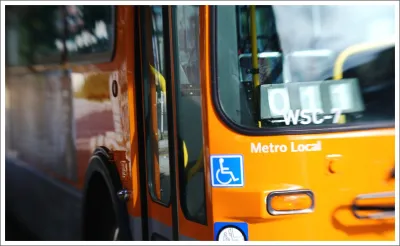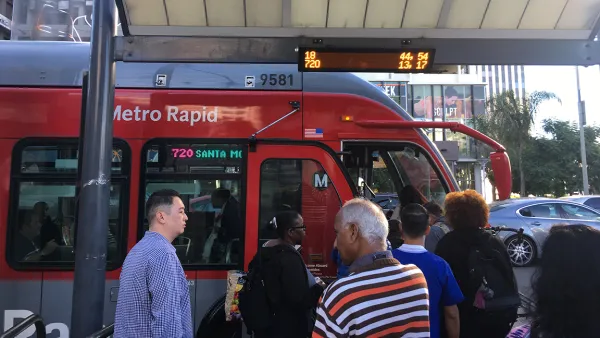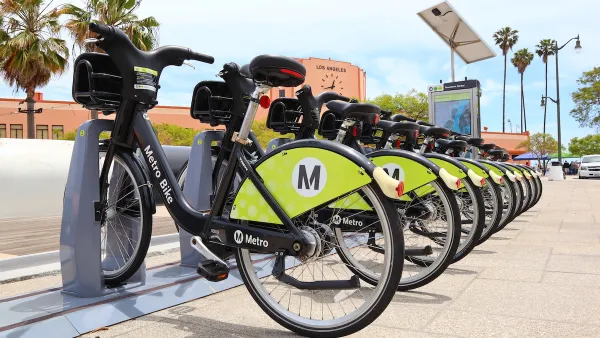One of the largest transit systems in the country continues to lose large numbers of riders. But the causes behind the drop and the solutions to stop it are hard to pinpoint.

Laura J. Nelson reports on the current state of transit ridership in Los Angeles County. The Los Angeles County Metropolitan Transportation Authority’s bus system alone has seen a drop in ridership of 25 percent, or 95 million trips, in the last decade.
The reasons for the decline vary and include a stronger economy—when people buy cars—and a decrease in immigration as well as a network of bus service that critics say does not meet the needs of riders.
"The bus exodus poses a serious threat to California’s ambitious climate and transportation goals. Reducing traffic congestion and greenhouse gas emissions will be next to impossible, experts say, unless more people start taking public transit," writes Nelson.
The solutions are varied as well. Metro has its eye on bringing in new riders who now drive by speeding up travel times and by better targeting service to places people need to go. But transit advocates say that improvements should focus more on the needs of existing riders, many of whom are Latino and black and are dependent on transit. They want Metro to put in more bus-only lanes and implement all-door boarding to decrease travel times, and they want to see more buses on the streets.
Still, the challenges to increasing ridership on buses in Los Angeles are immense. "When someone buys a car, they become less likely to take transit and more likely to drive, studies show. Non-car owners now have more alternatives than ever, including Uber and Lyft, car-sharing services like Zipcar, and rental bikes and scooters," notes Nelson.
FULL STORY: L.A. is hemorrhaging bus riders — worsening traffic and hurting climate goals

National Parks Layoffs Will Cause Communities to Lose Billions
Thousands of essential park workers were laid off this week, just before the busy spring break season.

Retro-silient?: America’s First “Eco-burb,” The Woodlands Turns 50
A master-planned community north of Houston offers lessons on green infrastructure and resilient design, but falls short of its founder’s lofty affordability and walkability goals.

Delivering for America Plan Will Downgrade Mail Service in at Least 49.5 Percent of Zip Codes
Republican and Democrat lawmakers criticize the plan for its disproportionate negative impact on rural communities.

Test News Post 1
This is a summary

Test News Headline 46
Test for the image on the front page.

Balancing Bombs and Butterflies: How the National Guard Protects a Rare Species
The National Guard at Fort Indiantown Gap uses GIS technology and land management strategies to balance military training with conservation efforts, ensuring the survival of the rare eastern regal fritillary butterfly.
Urban Design for Planners 1: Software Tools
This six-course series explores essential urban design concepts using open source software and equips planners with the tools they need to participate fully in the urban design process.
Planning for Universal Design
Learn the tools for implementing Universal Design in planning regulations.
EMC Planning Group, Inc.
Planetizen
Planetizen
Mpact (formerly Rail~Volution)
Great Falls Development Authority, Inc.
HUDs Office of Policy Development and Research
NYU Wagner Graduate School of Public Service





























